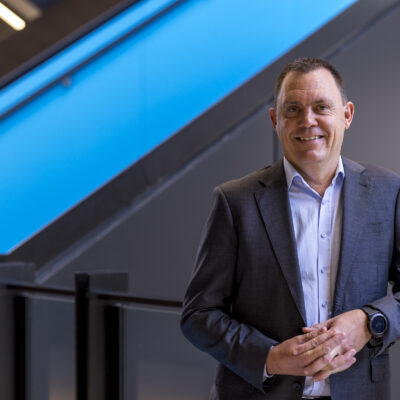Enabling and retaining the best frontline staff
Pictured above: Clayton Pyne.
Many Kiwi employers struggle to attract and motivate key frontline staff to achieve better business outcomes. Clayton Pyne, CEO of Humanforce, talks to NZBusiness about his company’s employee-centred technology platforms that are leading the way in staff management, engagement and motivation.
Right now, New Zealand is facing a crisis of talent in frontline workforces across key sectors. According to a recent survey by BusinessNZ, 87 percent of Kiwi employers have struggled to fill job vacancies in the past two years.
Clayton Pyne, CEO of HR tech solution provider Humanforce, says the pandemic shone a bright light on frontline and deskless workforces.
“In a positive sense the world came to understand the essential nature of these workers, who keep our supply chains moving and economies powering forward. We came to value the work conducted on the frontline in a whole new way – however, we also endured those lockdown periods when many of those workers, particularly in the retail and hospitality sectors, were displaced.”
He says, many left those jobs and did not return. The subsequent boost in immigration didn’t resolve the situation either, and organisations and business owners must now understand that the world is at an interesting intersection of work and life.
“Workers are now demanding more flexibility, clearer communication, better career development support, and empathy for the challenges that exist in frontline work. These are tough environments for workers.”
Clayton believes technology has a critical role to play in closing the gap in development, empathy, opportunity, and flexibility for frontline staff. Employers must also work on their value proposition for employees.
He says for business owners, the ROI in their workforce is only going to be maximised when they focus not just on traditional needs they have as an organisation, but equally on what they’re doing to really deliver on the needs of their employees around their wellbeing and the flexibility they have for frontline work.
Does your team have easy access to shifts and rosters, based on availability? Is it easy to get paid?
Do they feel heard? Can they personalise their employee experience?
“We believe it’s at this intersection of solving both the organisation’s needs and employees’ needs, where you can maximise that return on investment,” Clayton explains.
For frontline workers flexibility is about mobile. Humanforce research reveals that for 80 percent of those workers technology is becoming the most pivotal factor they’ll look at when choosing one job over another, and there is deep dissatisfaction with many technologies available out there.
Humanforce, on the other hand, has had great success with the adoption of its mobile-friendly app. “That’s where flexibility lives for a frontline worker,” says Clayton.
Maintaining a secure, engaged workforce
It’s important that employers with frontline staff utilise technology to make the employment experience positive. After all, the level of engagement you get from happy and engaged employees can be up to 16 times higher than you would otherwise achieve.
This equates to 41 percent less absenteeism, 24 percent less worker turnover, and ultimately, 17 percent higher productivity.
“In frontline businesses we can see anywhere from 50 percent to, in some cases, 100 percent in employee turnover,” Clayton explains. “The recruitment and hiring apparatus, and the cost of that, is enormous.
“Better to focus on employee engagement and experience, and really bring those figures way, way down.”
Ensure your frontline workers are being heard, he says. “Simple things like surveys and polls can provide important signals on actions you need to take with your workforce.
“You also need to analytically understand where your workers are at in terms of their development. A development module inside our HR offering allows you to look at things like individual employee performance and progress, and manager ratings. You can also look at the workforce aspect. What is a person’s absenteeism rate? What does their shift tardiness look like? What is their overtime acceptance rate?”
Human capital managementtechnology can bring together the everyday ‘hard data’ on shifts with the ‘soft data’ around employee engagement, performance, and their wellbeing and development, explains Clayton.
“This allows you to start predictive analytical work and help with the next best action you need to take to address any red indicators on the dashboard of those employees in question.
“You also have help to proactively take steps to reduce a team’s absenteeism and staff turnover and drive productivity.”
Above all, it’s about ensuring your people are valued, heard and supported, he says, which enables you to attract and retain people and drive a high-performing business or organisation.

Earned wage access capability
2024 is the right time to be taking supportive action around staff engagement and motivation, as challenging times can equate to financial hardship – particularly for lower income frontline workers. Frontline workers in sectors such as hospitality and retail are often stretched very thin.
Clayton says it’s important to build in solutions for such hardships, such as a alllowing employees to access their earned wage ahead of the payroll.
“If they’ve worked the shift and their manager has approved their timesheet, they can immediately draw down up to 50 percent of the wage they’ve earned for that shift.”
Fourteen percent of frontline workers struggle to pay their monthly bills. Earned wage access can definitely make a difference to the lives of employees, says Clayton.
“We also know that when companies take that supportive action, their workers are more likely to take that next shift or do a little bit more overtime, or simply clock-in on time.
“Across the product, we see 11 percent more hours are worked because those workers see that there’s a close alignment between the work they’re doing and reward they’re getting.”
Happy workers equals happy customers
Humanforce fundamentally believes that employee experience drives that business’s customer experience, which ultimately impacts on the bottom line.
“There is a causal link between the experience your staff have with you, the experience they drive for your customers, and ultimately the business returns in revenue and profit,” explains Clayton.
“A PWC survey has revealed that 73 percent of customers now say that the customer experience is the key deciding factor in whether they purchase from a company.”
Making work easier
‘Make work easier, and life better, for frontline workforces’ – that’s our key goal, says Clayton. “Business owners are urged to realise that your ROI in any technology or tool to help you manage and develop your team will be borne out of your ability to drive your organisation forward, along with your growth and profit, to ensure that your compliance posture and client confidence is absolutely locked in.
“You must complement that now with a genuine focus on your people. Give them control and flexibility over their working life with easy access to pay, time and schedules. Ensure that they feel heard and really feel part of your company.”
Humanforce is a full-suite, workforce human capital management platform designed to solve people challenges end to end and is suitable for SMBs right up to larger enterprises across a wide range of sectors.






